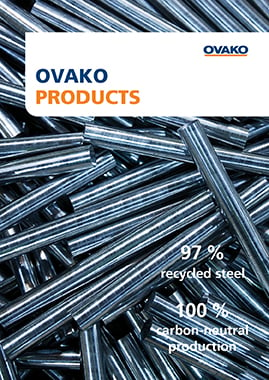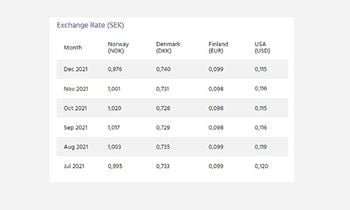Steel Navigator is our digital platform that helps designers and engineers choose the right steel for their application. The easy-to-use filtering system makes it possible to search through, several hundreds of Ovako´s steel grades and evaluate them according to the material properties that are most important for you.
Material Data Sheets
The Material Data Sheets (MDS) module is an important extension to our digital Steel Navigator. With just a few clicks of a mouse you can search our extensive database of steel grades to compare options and select the best
steel for your specific application.
The MDS has been designed by our steel experts to offer complete flexibility in the way that you search, with functionality based on building a candidate list of potential steel grades. You can search for a steel according to its numbering system (WNr), standard or steel grade number. You can also enter the steel composition directly as well as specifying the weldability
and hardenability you require.
Advantages of Steel Navigator
- Material Data Sheets (MDS) for you to search across several hundred Ovako steel grades using a filtering system based on the parameters that are most relevant to your application
- Apply the M-treatment to any steel grade. It uses a special treatment to modify the nonmetallic inclusions as well as closely regulating the levels of calcium, oxygen and sulfur
- The Ovako Heat Treatment Guide (HTG) aims to help you understand how different alloying elements influence steel hardness after quenching and/or tempering
- Piston Rod Predictor is designed to help you compare how different steel grades used in piston applications will resist buckling
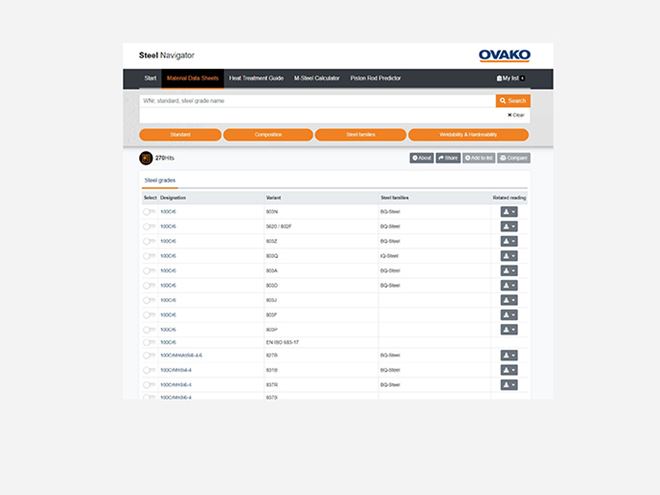
Suitable matches can be added to a list that can then be further refined according to a filtering system based on the parameters most relevant to your needs. The end result is a rated list of steel grades that provide the closest match, with the best match at the top. An additional benefit of the MDS module is that it offers extensive information about each steel grade including chemistry and mechanical properties, as well as important factors like weldability and machinability. It also provides links to useful further reading for each grade, such as our growing series of Technical Reports.
The detailed information for each steel grade is gathered on a product sheet that can be printed out immediately or saved for later use in the ‘My list’ function.
Heat Treatment Guide
Ovako has created an online Heat Treatment Guide to help mechanical design engineers evaluate the mech-anical properties after quenching and tempering of any grade of steel that contains the 13 most common alloying elements. This tool makes it possible to compare the heat treatment and tempering performance of thousands of steel alloys without the need for extensive desk research, calculations or testing.
While Ovako produces around 500–600 grades available as standard, there are many more specialist steel grades on the market. In theory, the number of grades is almost endless as steel properties vary depending on the alloying elements and their quantities.
Knowledge of hardenability is essential when designing systems and components such as bearings, power transmission systems and many other mechanical components.
Hardness is a mechanical property defined as the ability to withstand plastic deformation. The hardness of steel varies, according to the structure produced by quenching, depending on the mix and quantity of alloying elements in the steel. Engineers can adjust the final hardness through close control of the heat treatment process, specifically the cooling rate and temperature. This result is the optimum combination of toughness and hardness.
Choosing the right grade and optimizing the heat treatment and tempering can have a major influence on component performance and lifetime. Therefore, the heat treatment guide is an essential tool for mechanical engineers who need an easy way to determine the properties of their selected materials after quenching and tempering.
How to use the heat treatment guide
- When you load the page, you see a simple interface with a drop-down menu and fields for 13 alloying elements. A good starting point is to choose one of around 1,000 standard Ovako or International grades. This will auto- matically populate the percentage content of the 13 alloying elements, which you can keep or change.
- You can then add a second and subsequent rows. This lets you compare multiple grades and explore the subtle differences in harden- ability that result from varying the quantity of alloying elements.
- When you’re ready, click compare and the tool’s neural network will produce a set of graphs. The first two provide values for the hardness and tensile strength as tempering temperatures vary.
- The next two graphs provide data on harden- ability expressed as hardness as a function of cooling rate, as determined by Jominy testing, a standard method of comparing the hardness. A further three graphs show the hardness in the center of a bar when quenched with water, oil and air.
- Finally, Continuous Cooling Transformation (CCT) curves are provided to show the transformation between steel phases as the alloys are cooled at different rates.
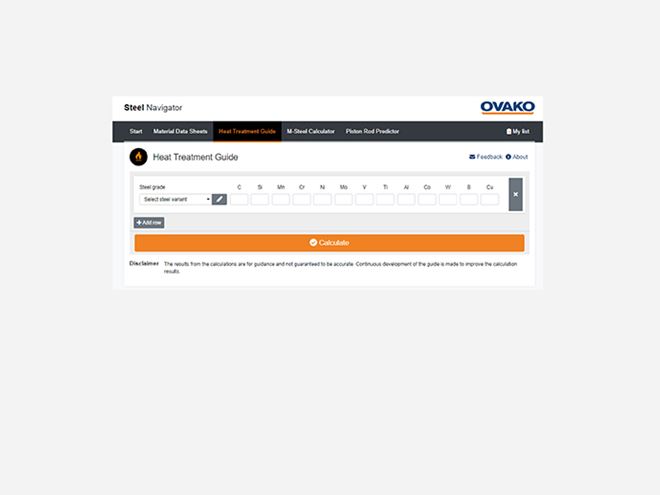
Using a neural network to model performance with some grades of steel, their hardenability during heat treatment and tempering are well documented. This is thanks to extensive laboratory testing, which has created a library of properties for well-known grades.
Engineers can estimate the performance of other, less well-documented grades by interpolation from the closest existing datasets. However, this is time-consuming and laborious.
To overcome this challenge, Ovako’s guide is based on a neural network that automatically interpolates the hardenability and toughness of almost any steel alloy. It was developed with a dataset that includes all the known data on heat treatment and tempering of steel. In total, it integrates around 100,000 data points for hardenability and more than 10,000 for tempering.
This approach provides mechanical design engineers with the best possible starting point to compare and contrast the properties of different alloys.
M-Steel Calculator
To optimize the success of machining, Ovako developed the M-Steel concept and works closely with customers to advise on cutting data and choice of tools. This is supported by machining tests that ensure the ideal material grade and dimensional characteristics are selected for a given application.
We have now taken this service to the next level with the M-Steel Calculator, based on Ovako’s Steel Navigator platform. This digital tool provides you with guidance in identifying the right machine settings based on the steel properties you wish to achieve and the cutting tools you plan to use.
To use the M-Steel Calculator visit the M-Steel Calculator site and then enter the relevant information for your cutting tool and work piece material. As the illustration shows, you are then presented with specific information on machine power, chip stream and the expected surface quality. The M-Steel calculator will also provide a comparison between these parameters when using M-Steel and a conventional steel. This will normally enable a saving of up to 30–40 % in production cost without losing any of the improvement in machining quality.
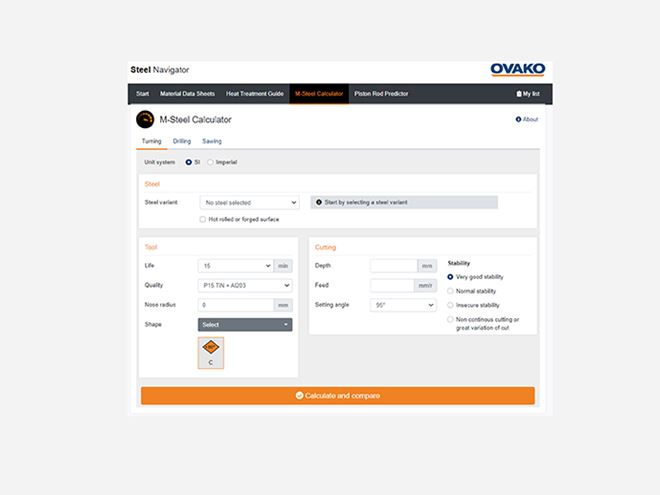
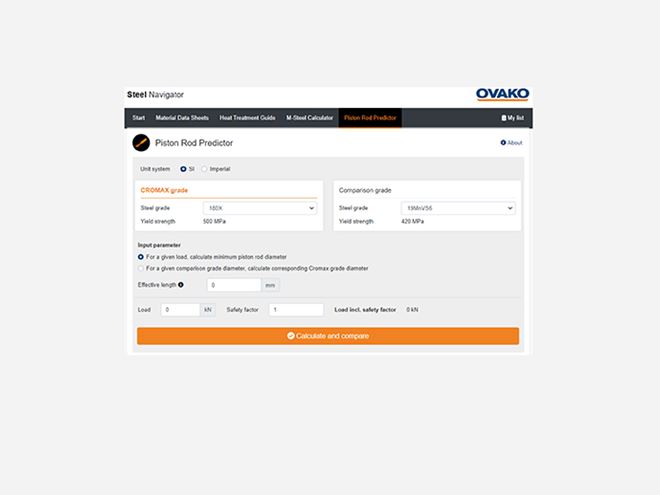
Piston Rod Predictor
We have developed a unique online tool, called the Piston Rod Predictor, to compare the resistance of different steel grades to buckling in piston rod applic-ations. The emphasis is on buckling because it is the key design consideration for hydraulic cylinders, especially in single-action, push-only applications.
Buckling is a sudden, large and unstable lateral deflec-tion associated with just a small increase in axial com-pressive load above a critical level - the buckling load. The stress corresponding to the buckling load can be far less than the yield strength of the material used to manufacture the rod.
Should buckling occur, it will result in instability and collapse of the piston rod. Buckling is therefore regarded as a highly dangerous failure mode that might result in serious accidents.
Using steel with higher strength provides better resist-ance to buckling. That offers the possibility to downsize piston rods, with a consequent reduction in both weight and cost. Ovako manufactures a range of hard-chrome-plated or nickel-chrome-plated ready-to-use bars and tubes, known as Cromax® developed specifically for hydraulic cylinders. The Piston Rod Predictor enables you to compare our Cromax steel grades with the most commonly used standard grades. If the grade you wish to compare is not listed, you can still enter its relevant mechanical properties manually.
You can use the Piston Rod Predictor in two ways. You could choose to input an existing rod diameter to cal-culate what diameter would be required to achieve the same safety factor with an alternative steel grade. Or you could keep the diameter the same, but evaluate how using a stronger steel intended specifically for piston rods might enable the design load to be uprated.
Alternatively, you can use your maximum load and desired safety factor to calculate the minimum rod diameter for different steel grades.
We made it! But we are still not satisfied
What a journey! It took years of hard work to make our steelmaking operations more sustainable. In 2022, we went carbon neutral in all operations. But we´re still not satisfied - our journey towards steel production without CO2 emissions continues.
Read more about our path to carbon neutrality

